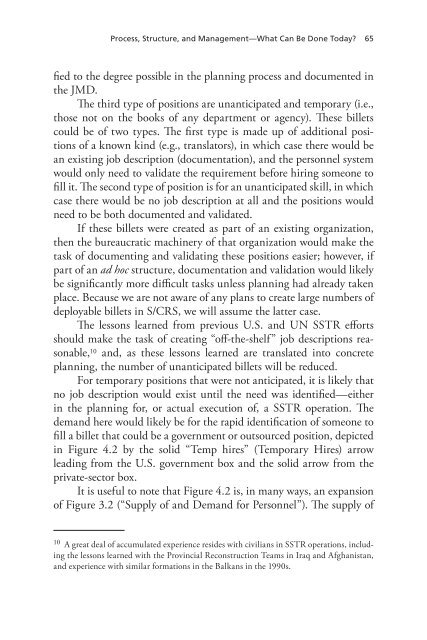Stabilization and Reconstruction Staffing - RAND Corporation
Stabilization and Reconstruction Staffing - RAND Corporation
Stabilization and Reconstruction Staffing - RAND Corporation
You also want an ePaper? Increase the reach of your titles
YUMPU automatically turns print PDFs into web optimized ePapers that Google loves.
Process, Structure, <strong>and</strong> Management—What Can Be Done Today? 65fied to the degree possible in the planning process <strong>and</strong> documented inthe JMD.The third type of positions are unanticipated <strong>and</strong> temporary (i.e.,those not on the books of any department or agency). These billetscould be of two types. The first type is made up of additional positionsof a known kind (e.g., translators), in which case there would bean existing job description (documentation), <strong>and</strong> the personnel systemwould only need to validate the requirement before hiring someone tofill it. The second type of position is for an unanticipated skill, in whichcase there would be no job description at all <strong>and</strong> the positions wouldneed to be both documented <strong>and</strong> validated.If these billets were created as part of an existing organization,then the bureaucratic machinery of that organization would make thetask of documenting <strong>and</strong> validating these positions easier; however, ifpart of an ad hoc structure, documentation <strong>and</strong> validation would likelybe significantly more difficult tasks unless planning had already takenplace. Because we are not aware of any plans to create large numbers ofdeployable billets in S/CRS, we will assume the latter case.The lessons learned from previous U.S. <strong>and</strong> UN SSTR effortsshould make the task of creating “off-the-shelf” job descriptions reasonable,10 <strong>and</strong>, as these lessons learned are translated into concreteplanning, the number of unanticipated billets will be reduced.For temporary positions that were not anticipated, it is likely thatno job description would exist until the need was identified—eitherin the planning for, or actual execution of, a SSTR operation. Thedem<strong>and</strong> here would likely be for the rapid identification of someone tofill a billet that could be a government or outsourced position, depictedin Figure 4.2 by the solid “Temp hires” (Temporary Hires) arrowleading from the U.S. government box <strong>and</strong> the solid arrow from theprivate-sector box.It is useful to note that Figure 4.2 is, in many ways, an expansionof Figure 3.2 (“Supply of <strong>and</strong> Dem<strong>and</strong> for Personnel”). The supply of10 A great deal of accumulated experience resides with civilians in SSTR operations, includingthe lessons learned with the Provincial <strong>Reconstruction</strong> Teams in Iraq <strong>and</strong> Afghanistan,<strong>and</strong> experience with similar formations in the Balkans in the 1990s.
















